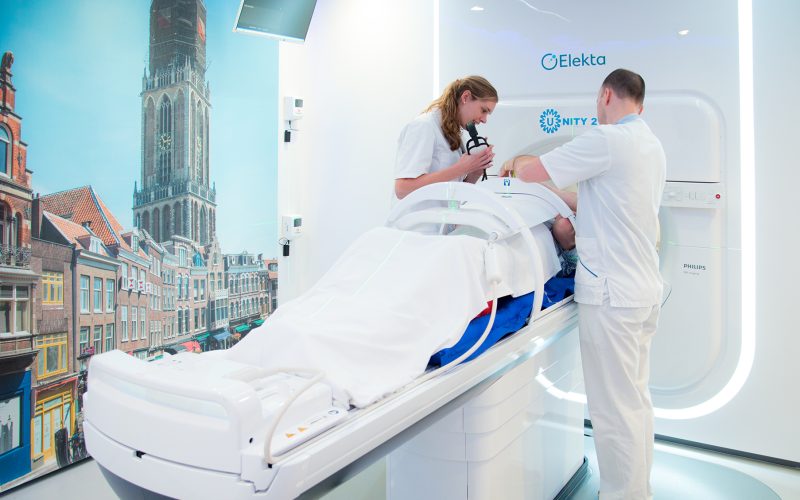Less radiation sessions with the MR-Linac. And with even more precision. This is not only less stressful for patients with prostate cancer, but also ensures that more patients can be treated more quickly. UMC Utrecht will now investigate whether two radiation sessions should become the new standard treatment.
The MR-Linac is a combination of a radiotherapy machine and an MRI scanner, which can be used to irradiate prostate cancer very precisely. Surrounding organs (such as the bladder and rectum) are less exposed to a high amount of radiation than with the usual radiation method. As a result, there is also less chance of unpleasant side effects, such as urination or defecation problems.
Due to the higher precision of the MR-Linac, it’s also sufficient to administer radiation less often, because a higher dose can be given to the prostate at once. As a result, people need to travel to the hospital less often.
With intermediate-risk prostate cancer, five radiation sessions with the MR-Linac have become the standard treatment. During the TURBO study, it will now be investigated whether patients could also be cured in fewer hospital visits: from five to two radiation sessions with the MR-Linac.
“What’s new is that we’ll make an MRI scan every two seconds during the radiation treatment.”
Jochem van der Voort van Zyp, radiotherapist-oncologist and associate professor at UMC Utrecht: “We use comprehensive motion management. What is new in this study is that we will make an MRI scan every two seconds during radiation therapy. This will allow us to check whether the tumor is still located in the radiation field. If the tumor moves out the radiation field, we will adjust the field, enabling us to continue the radiation therapy very accurately. In this way, we will not only be able to shorten radiation schedules, but to also safely administer a higher dose to the prostate.
The researchers will irradiate 80 people twice and compare the results with those of the same number of patients who’ll receive the standard MR-Linac radiation treatment (five sessions). They will evaluate if there is a difference in the number of side effects. And they will also monitor whether two radiation sessions with a slightly higher dose will lead to a better control of the prostate cancer.
“Sustainable care is future-proof care, and that’s what we’re focusing on with this study.”
Physician-researcher Tariq Lalmahomed: “Within the TURBO study, we will monitor all 160 participants for five years: we will regularly ask them about any side effects of the treatment, and we will monitor the PSA value. (An elevated level of the protein PSA could be an indication for prostate cancer – ed.) This allows us to stay on top of any possible changes, and to respond quickly to our findings. Ultimately, we would like to learn from every patient. We hope to be able to draw definitive conclusions by mid-2030. Maybe this will become the standard treatment for everyone with intermediate-risk prostate cancer!”
If the TURBO study will turn out to be positive, this will be good news not only for the treated patients but also for healthcare in general. That is, fewer MR-Linac sessions will then be needed, more people will be able to receive treatment in the same time span, and patients will be treated sooner.
“Sustainable care is future-proof care, and that’s what we’re focusing on with the TURBO study,” says Tariq. “By reducing the number of radiation sessions, we will be able to make prostate cancer care more efficient and, in the long run, less expensive. Our goal is to provide every patient with the best possible care, while bearing in mind society as a whole.”
Do you have intermediate-risk prostate cancer, and would you like to participate in the TURBO study?
Talk to your treating specialist about whether this study might be suitable for you and whether you meet the requirements.
Important to know: if you participate, you will not automatically receive two radiation sessions. It is decided randomly whether you will fall into the test group (two sessions) or the control group (standard treatment).
Would you like to know more about this research? Please send an e-mail to TURBO-studie@umcutrecht.nl
The MR-Linac was invented by UMC Utrecht and developed together with Philips and Elekta, among others. The device radiates tumors and makes MRI scans at the same time, which allows for better visibility and more precise treatment of the cancer.
The MR-Linac is used to treat various types of tumors, such as prostate cancer. On this website, we have assembled all relevant information about the MR-Linac treatment of prostate cancer.
